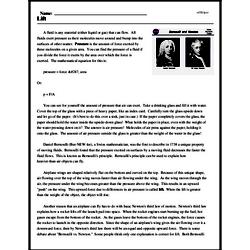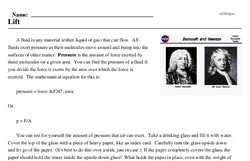Lift
A fluid is any material (either liquid or gas) that can flow. All fluids exert pressure as their molecules move around and bump into the surfaces of other matter. Pressure is the amount of force exerted by these molecules on a given area. You can find the pressure of a fluid if you divide the force it exerts by the area over which the force is exerted. The mathematical equation for this is:
pressure = force ÷ area
Or:
p = F/A
You can see for yourself the amount of pressure that air can exert. Take a drinking glass and fill it with water. Cover the top of the glass with a piece of heavy paper, like an index card. Carefully turn the glass upside down and let go of the paper. (It's best to do this over a sink, just in case.) If the paper completely covers the glass, the paper should hold the water inside the upside-down glass! What holds the paper in place, even with the weight of the water pressing down on it? The answer is air pressure! Molecules of air press against the paper, holding it onto the glass. The amount of air pressure outside the glass is greater than the weight of the water in the glass!



